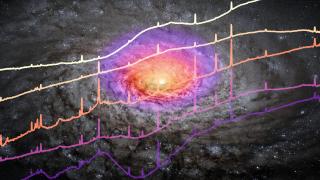Bibcode
Ramos Almeida, C.; Esparza-Arredondo, D.; González-Martín, O.; García-Bernete, I.; Pereira-Santaella, M.; Alonso-Herrero, A.; Acosta-Pulido, J. A.; Bessiere, P. S.; Levenson, N. A.; Tadhunter, C. N.; Rigopoulou, D.; Martínez-Paredes, M.; Cazzoli, S.; García-Lorenzo, B.
Referencia bibliográfica
Astronomy and Astrophysics
Fecha de publicación:
1
2023
Revista
Número de citas
16
Número de citas referidas
16
Descripción
Mrk 477 is the closest type-2 quasar, at a distance of 163 Mpc. This makes it an ideal laboratory for studying the interplay between nuclear activity and star formation with a great level of detail and signal-to-noise. In this Letter we present new mid-infrared (mid-IR) imaging and spectroscopic data with an angular resolution of 0.4″ (∼300 pc) obtained with the Gran Telescopio Canarias instrument CanariCam. The N-band (8-13 μm) spectrum of the central ∼400 pc of the galaxy reveals [S IV]λ10.51 μm emission, but no 8.6 or 11.3 μm polycyclic aromatic hydrocarbon (PAH) features, which are commonly used as tracers of recent star formation. This is in stark contrast with the presence of a nuclear starburst of ∼300 pc in size, an age of 6 Myr, and a mass of 1.1×108 M⊙, as constrained from ultraviolet Hubble Space Telescope observations. Considering this, we argue that even the more resilient, neutral molecules that mainly produce the 11.3 μm PAH band are most likely being destroyed in the vicinity of the active nucleus despite the relatively large X-ray column density, log NH = 23.5 cm−2, and modest X-ray luminosity, 1.5×1043 erg s−1. This highlights the importance of being cautious when using PAH features as star formation tracers in the central region of galaxies to evaluate the impact of feedback from active galactic nuclei.
Proyectos relacionados

Actividad Nuclear en Galaxias: una Perspectiva 3D del Núcleo y su Entorno
Nuestro proyecto puede dividirse en dos líneas principales de investigación. En primer lugar, el estudio de los vientos producidos por cuásares luminosos oscurecidos y del impacto que estos tienen en sus galaxias anfitrionas (retroalimentación del AGN). Para ello hemos obtenido observaciones en el óptico e infrarrojo cercano con el Gran Telescopio
Cristina
Ramos Almeida